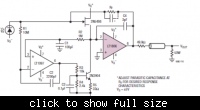aakeni
Newbie level 2

Hello, please i need your help to understand this statement below with reference to the circuit above:
STATEMENT:
Given this amplifier circuit in the diagram above for a photodiode from LinearTechnologies, With resistor value RF varied from 100kOhms to 1MOhms, total output noise was below 1mV (RMS) measured over a 10MHz bandwidth.
The -3dB Bandwidth is 4.6MHz (RF =200kOhm); As a result, we can use a 1MHz or 2MHz modulation frequencies for the background cancelation.
MY QUESTION:
1. Why was a 1MHz or 2MHz chosen as modulation frequency for background cancellation? and why do we need background cancellation?
2. What is the importance of knowing the total output noise?
3. What is meant by 10MHz bandwidth? and why was this band of frequency chosen?
I'm ashamed2 ask because the question may look lame to experienced people, but i dont know it and will greatly appreciate your answer.
Abel